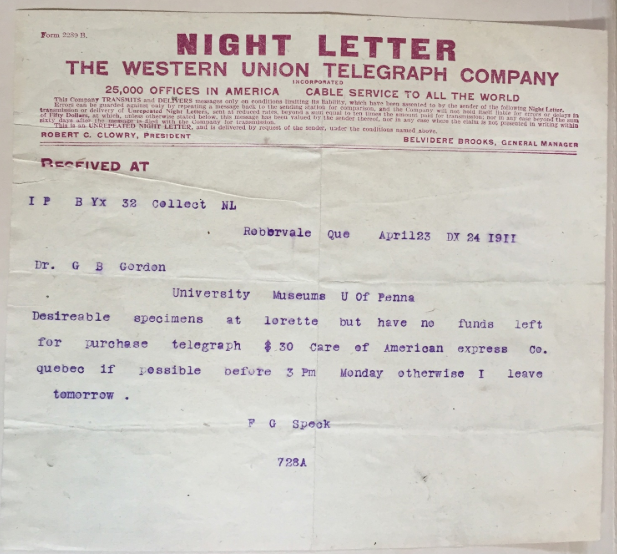This week I finished digitizing the rest of the Frank Speck lantern slides. I also finished cross-examining the lantern slides with the printed photographs, again finding duplicates and more identifying information, such as names and places. After I finished up with that, I was able to visit the University of Pennsylvania’s Museum Archives in search of any information could possible provide some context for the lantern slides. The Penn Museum Archives houses the papers of Samuel Pennypacker, one of Speck’s students. The papers included notes taken by Pennypacker for anthropology courses taught by Speck at Penn. I was hoping that going through class notes would give me an idea of how Speck used the lantern slides during his lectures. Unfortunately, I did not find anything revelatory. The class notes were somewhat vague, and the only thing I can assume is that Speck may have used the lantern slides when discussing various examples and case studies.
Even though I didn’t find exactly what I was looking for, I did come across several pieces of information that have sparked my interest. Perhaps the most intriguing to me was how much of the material dealt with Speck’s desire to purchase and sell Indigenous material culture he labeled as significant or of value. It appears that when Speck traveled to Indigenous communities, and obtained such items with the intention of selling them to the Penn Museum or elsewhere. I even found correspondence between Speck and individuals specializing in, “Indian Relics and Curios.”
Obtaining and collecting such objects was commonplace for a number of anthropologists, including James Mooney, Edward Palmer, and M.R. Harrington (Meyer, 220). It appears that Samuel Pennypacker had an extensive collection of relics at his home in Schwenksville, PA. An appraisal of his personal property conducted after his death records the hundreds of relics he had stashed away. Obsessed with the idea of authenticity, anthropologists invested in personal collections, believing that these items were increasing in value as Indigenous people were on the path to extinction. The commodification and commercialization of Indigenous objects has led to the establishment of a perceived sense of authentic “Indianness” in the United States; a stagnant identity that leaves no room for cultural change, evolution, or adaptation.
If nothing else, going through these papers causes me to question the motives these anthropologists as well as the implications their work had on the communities they studied. It seems a bit ironic how these anthropologists objectified Indigenous communities through the obsessive collection of Indigenous objects.
Meyer, Carter Jones. 2005. Selling the Indian commercializing & appropriating American Indian cultures. Tucson: Univ. of Arizona Press.
***All opinions and reflections are my own and do not reflect those of the American Philosophical Society or its employees.***
Hours Logged: 21
Total Hours: 56



